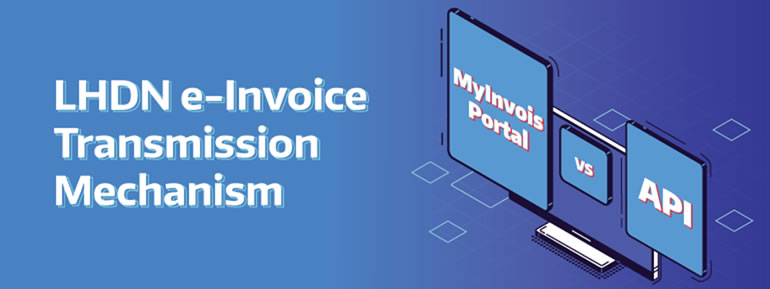
LHDN e-Invoice Transmission Mechanism
The LHDN e-invoice is a standardized e-invoice format that transmits through electronic system that stand between issuer(supplier) and receiver (buyer), which the issuer will send the e-invoice to Inland Revenue Board of Malaysia (IRBM) for validation before forwarding it to the receiver, and while the process will not be operating on the usual email system but in a specific format, the e-invoicing process transmit and communicates data with its own ways.
As for now, LHDN has identified two main method the invoice transmission will take place, which is through MyInvois Portal which hosted by LHDN or through Application Programming Interface (API) so what are the differences between the two?
MyInvois Portal
For MyInvois Portal, it will be a web portal hosted by IRBM which contains all the functionalities required for taxpayers (supplier) to perform e-Invoice actions (i.e., generate, submit, view, cancel or reject invoice,etc.) the main benefits of utilizing MyInvois are:
- It is easily accessible by everyone,
- It provides convenience to MSMEs to issue invoices, especially those who are unable to issue from their system or does not own a system.
- Businesses which connection to API is temporarily not available.
Taxpayers are required to login to MyTax Portal to utilize MyInvois Portal to perform their e-Invoice in accordance with the rules and requirements outlined by IRBM. And MyInvois also enables individual invoice generation through a comprehensive form, along with the option for batch generation through spreadsheet upload for processing multiple transactions at one go, but even though multiple invoices are enabled, MyInvois Portal is still not designed to handle substantially large volume of invoices compared to API.
API
Another transmission method is by the API, API allows the e-Invoice function to be programmed into system that are interactable with the solution, such as AutoCount Accounting, which further promotes automation in e-invoicing processes. API allows taxpayers or users to share e-invoices directly to IRBM for validation within the current system they were using, methods to transmit e-Invoice via API include:
- Direct integration of taxpayers’ ERP system with MyInvois System.
- Through Peppol service providers.
- Through non-Peppol technology providers.
Even though API requires technology and adjustments to existing system, it is more suitable for medium and large companies as it allows user to transmit high-volume of invoices.
2 e-Invoice Transmission Mechanisms
While the transmitting mechanism is different, the API will require pre-installation of the system prior to e-invoice transmitting and submission below are the difference of both flows.
| MyInvois Portal | API |
|---|---|
| Login into the portal | Develop an API integration between your e-Invoicing system and the IRBM's system. |
| Create invoice after login | Generate e-Invoice in invoicing system |
| Enter the invoice details, such as the invoice number, date, customer information, and itemized list of items. | Submit to IRBM directly within the API system or solutions |
| Submit for IRBM validation |
You will receive a notification once the invoice has been submitted successfully.
If you need more information on the whole e-Invoice submission workflow, please click here.
The best submission method for you will depend on your specific needs and requirements. If you are unsure which submission method is right for you, then you should consult with a qualified e-Invoicing solution provider, start preparing for e-Invoice to stay compliant, and work more efficiently, contact AutoCount today to find out more!